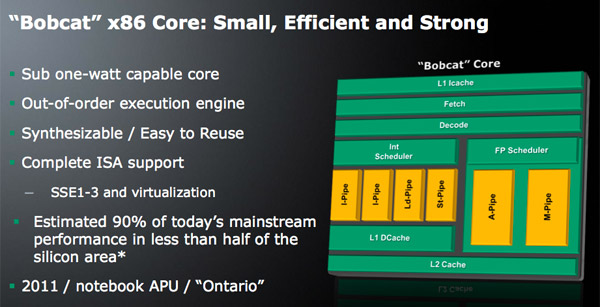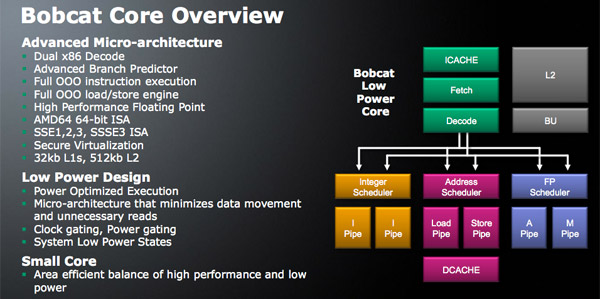AMD Discloses Bobcat & Bulldozer Architectures at Hot Chips 2010
by Anand Lal Shimpi on August 24, 2010 1:33 AM ESTPhysical Register Files to Save Power
The original x86 instruction set has a very limited number of registers (8). In order to maintain backwards compatibility with legacy x86 code, the ISA and associated registers were preserved. To scale performance with wide out of order architectures however, we needed larger register files. The solution was to enable register renaming, where the hardware could have additional registers not defined in the x86 spec and rename them on the fly.
Register renaming is done in all modern day x86 processors. There are two approaches to register renaming. The current Phenom II/Opteron approach actually carries the data from renamed registers along with the instruction as it moves through queues before it gets executed. You effectively create very wide instructions, which is horribly power inefficient (moving data on a chip takes a lot of power) although it gets the job done from a performance standpoint.
The alternative is something that we don’t see used in any current generation microprocessors. Instead of carrying data along with the instructions, you simply carry pointers to the data with those instructions. There’s added management complexity but you don’t have to worry about moving lots of data around, and therefore avoid much of the power penalty.

Bobcat (as well as Bulldozer) uses physical register files to save power. Intel actually did this in the Pentium 4 but hasn’t used PRFs since. AMD argues that with power as a major driver of design, PRFs will be necessary in future architectures.
Bobcat’s Performance Expectations
With nearly the same pipeline depth as Atom (15 vs. 16 stages), nearly the same cache latencies, the same instruction issue width and presumably competitive clock speeds (~1.5GHz), Bobcat based microprocessors should inherently outperform Atom thanks to its out of order architecture.
Atom does hold an advantage in that each core is multithreaded, so heavily threaded apps may have an advantage on Intel’s architecture. That being said, by far the biggest issue we have with Atom based netbooks is their single threaded performance that contributes to an overall slow user experience. Bobcat should hopefully address that.
On the threaded side, AMD does have another solution. As I mentioned before, Bobcat won’t be used in a microprocessor by itself - Ontario will feature two of them. AMD said that future designs are expected to integrate 2 or 4 Bobcat cores, while there are no plans to produce a single core version it’s always possible.

I believe a dual core Ontario based on Bobcat, if clocked high enough, could deliver a good enough balance of single and multithreaded performance to really challenge Atom in the netbook space. The assumption is that graphics performance will be much better than Atom with Ontario integrating an AMD GPU.
AMD’s official line is that Ontario will be able to deliver 90% of the performance of a mainstream notebook in less than half the die area. AMD isn’t just looking to compete with Atom, but go after even the CULV market with Ontario. Only time will tell if the latter is over zealous.
Power Concerns
AMD calls Bobcat sub-1W capable, which seems to imply that short of a smartphone Bobcat could go anywhere Atom could go. Technically, if AMD wanted to, even getting one into a smartphone wouldn’t be impossible - it would just require a healthy investment in chipsets.

It remains to be seen how good TSMC’s 40nm process will be compared to Atom’s Intel-manufactured 45nm transistors in terms of power consumption. Presumably the out of order aspect of the design will guarantee higher power consumption than Atom, but for the netbook/CULV notebook market the added performance may be worth the added power consumption.










76 Comments
View All Comments
SuperiorSpecimen - Tuesday, August 24, 2010 - link
Let's see some competition outside of the price game!mrmojo1 - Tuesday, August 24, 2010 - link
Awesome article, can't wait to see their release :) Should be very interesting!crawmm - Tuesday, August 24, 2010 - link
I drooled on my laptop reading this. Thank you, Anand. Good overview. And fun reading after a day of tedious (and mindless) work.lothar98 - Tuesday, August 24, 2010 - link
"In many ways the architecture looks to be on-par with what Intel has done with Nehalem/Westmere."I truly hope that this does not end up to be how things roll out. It has been far too long since we have seen good competition throughout the range of consumer CPU lineup. Currently we have options and competition in the mid-low end giving us exceptional bang for our buck. While one would never say you can get the best bang for your buck in the mid or high end everyone can still appreciate having options as well as getting value.
Freddo - Tuesday, August 24, 2010 - link
Bobcat seems very interesting to me, I hope it won't take long until we see a good netbook with it, with good build quality (metal, no plastic toy), a HDMI port and 2GB RAM.Mike1111 - Tuesday, August 24, 2010 - link
I'm wondering: what about AMD powered notebooks? And I don't mean netbooks or CULV notebooks. Looks like bulldozer won't come to notebooks until 2012, which would mean that AMD would most likely have to compete with Intel's 22nm Sandy Bridge successor, Ivy Bridge.Penti - Tuesday, August 24, 2010 - link
Llano APU, it's briefly mentioned. It's where we're at. Basically K10-based 4-core with integrated DX11 GPU. Better then today but not much of a competition.mino - Tuesday, August 24, 2010 - link
The GPU in the is supposed to be at least 5x the speed of current IGP performance.Basically you get a "discrete" GPU for a price of IGP ...
MonkeyPaw - Tuesday, August 24, 2010 - link
I can see Bobcat scaling upward in notebooks. It's multi-core capable, and is a fully-functional CPU. A quad core Bobcat with better-than-Intel graphics should be a very fulfilling product for notebooks in the mid-range, while providing good battery life (thank you, power gating). Anything above that could be handled by low-voltage Bulldozers as a premium offering. To me, that seems like a better solution than Intel's, where the Atom to Core increase is so severe.Kiijibari - Tuesday, August 24, 2010 - link
Ehh guys ...MMX is depracated in 64bit mode together with x87 and 3Dnow!:
--------
The x87, MMX, and 3DNow! instruction sets are deprecated in 64-bit modes. The instructions sets are still present for backward compatibility for 32-bit mode; however, to avoid compatibility issues in the future, their use in current and future projects is discouraged.
--------
http://msdn.microsoft.com/en-us/library/ee418798%2...
Why on Earth should AMD build in 2 special MMX pipes in a brand new µarchitecture ?
AMD just announced that they got rid of 3Dnow!, MMX pipes make no sense at all.
You probably mean XOP, dont you ?